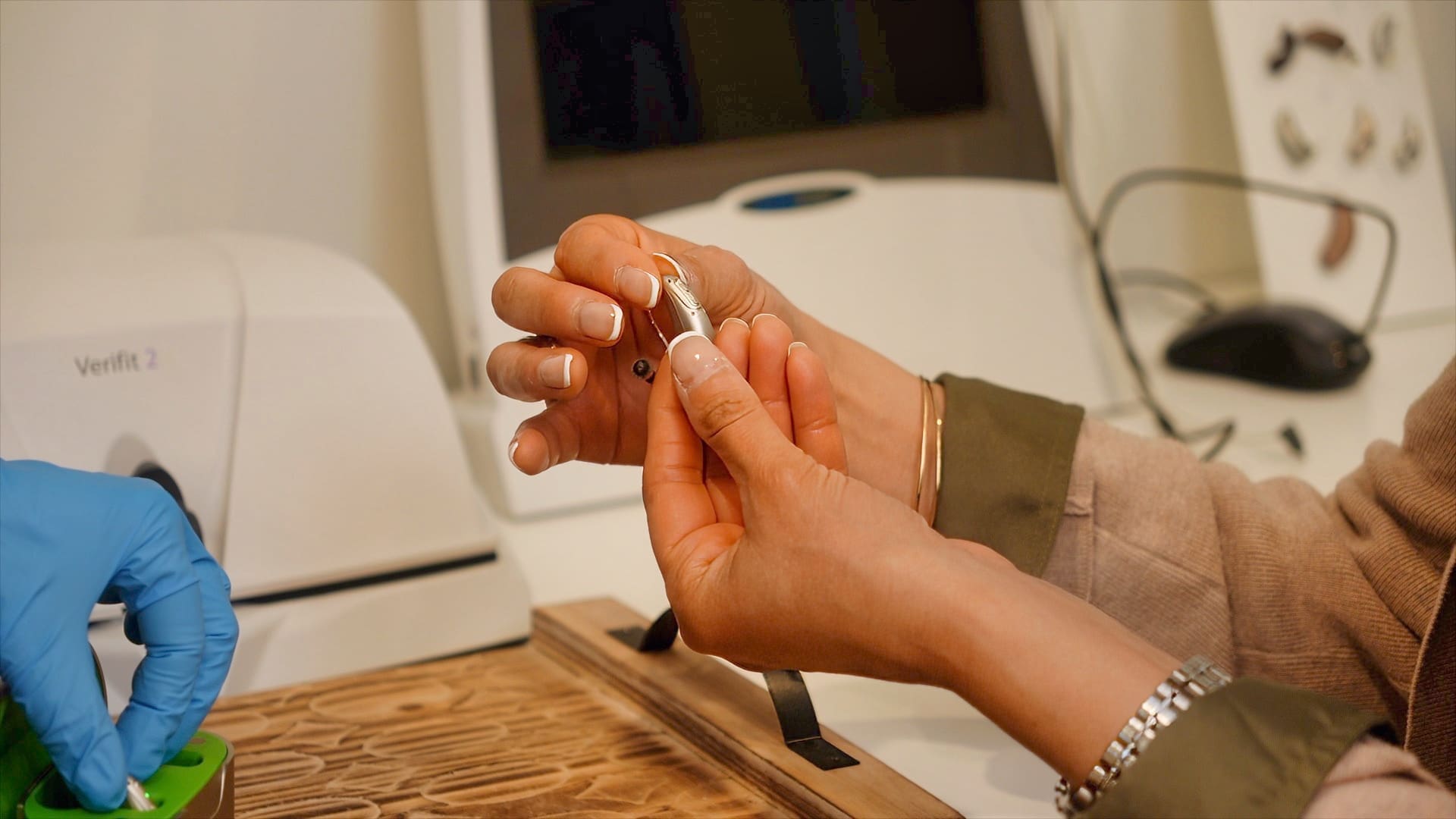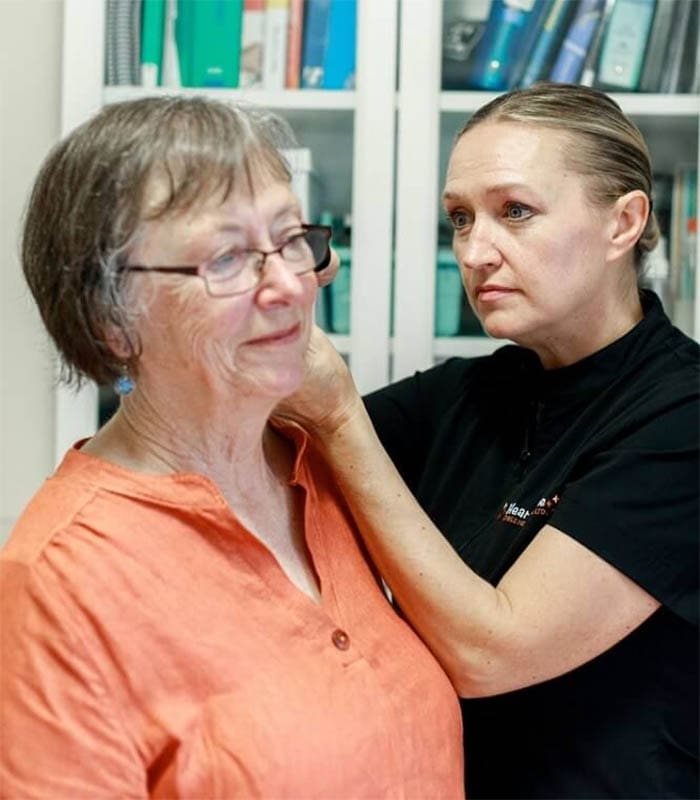
Hearing aids usually provide the best solution to help individuals with a hearing loss continue to go on with their daily life, but are there situations and circumstances when hearing aids aren’t enough?
Hear at Home recognizes that you might need something more than your hearing aids to enjoy a better hearing experience and richer quality of life.
In addition to fitting you with hearing aids and providing ongoing support, we provide assistive hearing technology to boost your ability to communicate in public and private settings by filling in the gaps for hearing aid users.
Assistive hearing technology can be broken down into two different types of devices: assistive listening devices (ALD) and assistive listening systems (ALS).
Assistive listening systems (ALS) help individuals with hearing challenges to hear better in places like theatres and lecture halls.
Specifically designed for people with a hearing loss, amplified devices allow you to turn up the volume in order to hear speech clearly whether you’re wearing your hearing aids or not, and they often come with amplified ringtones so you’ll never miss a call.
Captioned phones provide real-time captioning, like the closed captions you see on TV, and are particularly helpful for people with a severe to profound hearing loss.
By law, telephone manufacturers, including iPhone and Android smartphones, must make phones compatible with hearing aids. Hearing aid compatible phones usually use either acoustic coupling, which amplifies sounds from the phone as well as any noise around you, or telecoil coupling, which requires a special feature that only picks up the phone conversation while blocking out background noise.
Some smartphone apps can serve as their own unique ALDs, like caption apps that provide text translation for speech.
Turning up the volume on your television isn’t always the best option for those around you and it can distort the sound, making it even more difficult to understand. Some television amplifiers work even without hearing aids, such as TV Ears® or a wireless headset with a personal volume control that plugs directly into your TV’s earphone socket.
Alerting devices typically rely on amplified sounds, visual cues and even vibrations to alert you to sounds in your environment. Some examples are vibrating alarm clocks and doorbell alerts that flash the lights to let you know someone is at your door as well as vibrating and flashing smoke and carbon monoxide detectors.
Hearing Loops (aka induction loops or audio frequency induction loop systems). They include a system of copper wire placed within a room, theatre or counter connected via a special loop “driver” to a public address or sound system. Sound is wirelessly transmitted via small changes in the magnetic field and is directed into the telecoil of hearing aids, cochlear implants or telecoil receivers worn on the body.
FM or DM Systems (radio frequency assistive listening systems). This type of ALS transmits wireless, low-power FM frequency radio transmissions from a sound system to FM receivers. Using the system requires a receiver and either headphones or a neckloop, but those with telecoil-equipped hearing aids or neckloops do not need headphones.
Infrared Systems (IR). Speech or sound transmission from a public address system uses invisible infrared light waves to send signals from a transmitter to an IR receiver. This technology requires line-of-sight and is interrupted in direct sunlight.
Assistive listening systems (ALSs) are used in public settings such as a theatre, airport, church or lecture hall.
There are three approved types of Assistive Listening Systems:

Have Hearing Complications? Contact Us Today
Jennifer was great at understanding our needs and addressing them. She made the entire process… read more very smooth and comfortable for my father.
Hear at Home consistently exceeds my expectations. Honest, friendly staff providing energetic service at the highest… read more level. Jennifer, Emma & Maia & Holy … Many thanks, you’re an awesome team.
My mom had her hearing tested recently by Jennifer from Hear at Home. Jennifer… read more was very thorough and explained what she was doing each step and why. It has been a big improvement for my mom and her quality of life. Jennifer comes to her care home for follow up visits and addresses any specific issues she may have. She is very personable and works well with seniors. I highly recommend Jennifer and the staff at Hear at Home Mobile Clinic
Got mom’s hearing aids here. The staff have all been wonderful. Explained everything to… read more my mom, were very patient, easy parking. When looking around for hearing aids for mom, I know cost*o prices are lower, but for my mom, who has mobility issues, it’s just way better to have a place closer to home, with parking within meters of the storefront, who can get her in the next day or possibly that same day if needed. Mom is very happy with her hearing aids. One of them got damaged & they got me in very fast & had a new one ready at no charge. Very happy we went with them. Now if I could only convince dad he should get them too..
Very satisfying. This crew definitely knows what they are doing.
I had the best experience with Hear at Home. Jennifer is so professional and always… read more thinking from the patient’s perspective. The hearing aids is for my Mom, who is 91 years old. The mobile service is perfectly for us. I appreciated all her suggestions and enjoyed every time she visited us. I can feel that she is full of love in her career. The whole team of Hear at Home is Great too. To summarize, I would like to say that the service is awesome and the fee is definitely affordable and reasonable.
Very friendly and experienced personnel. I brought my mother, 90 years old for wax cleaning… read more two times. From the entrance door we are friendly greeted by receptionist Maia and right away we are offered either cappuccino, tea or water. Holy, hearing practitioner, was very careful working with my old mother, taking care about her ears, carefully cleaning with warm water. And what is the most important, after two sessions my mother’s ears are clear from wax, and she can hear again. Thank you
I had impacted ear wax from using ear plugs and riding motorcycles with ear plugs.… read more I have a very minor case of tinnitus that I have habituated to but when it comes to ear cleaning I’ve never had a good experience at the GP or walk in clinic. After having my ear wax impacted I found hear at home and booked an appointment. Hear at home uses a curette method which is manual removal and also uses irrigation. This was the most gentle, understanding and positive experience I’ve ever had. I want to say a huge thank you to Holy Desta for being so patient and kind with me. Extremely professional and I would highly recommend her and Hear At Home. Once again, thank you for the professional and kind service, I will be coming back in the new year to have my ears looked at again. Thank you
Very great customer service, helping me with getting what I need. I will definitely go… read more back again 🙏
If you’re homebound, struggle with mobility or are concerned about your safety in public, but need the advanced hearing healthcare a hearing specialist can provide, Hear at Home has you covered.
Have Questions? We can help

Disclaimer
Hear at Home Practitioners are licensed by the College of Speech and Hearing Health Professionals of British Columbia. Any unresolved concerns they may have about the registrant’s practice may be reported to the College: College of Speech and Hearing Health Professionals of British Columbia 900 – 200 Granville St, Vancouver, BC, V6C 1S4
Phone: 604.742.6380
Toll-free: 1.888.742.6380
Email: enquiries@cshbc.ca






© 2025 Hear at Home Mobile Hearing Clinic